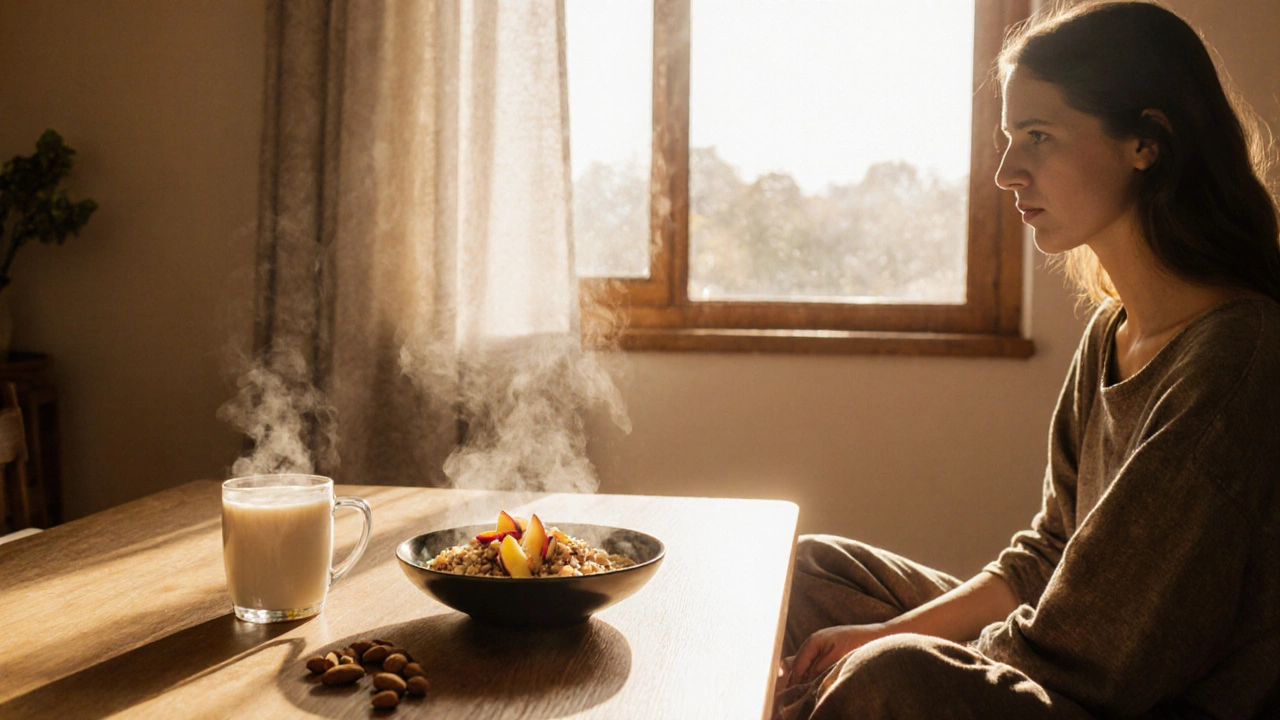-
12

Ayurvedic Eating Times: When to Eat for Best Digestion
Ayurvedic Meal Timing Calculator
Select your dominant dosha to find your optimal eating schedule according to Ayurvedic principles. Your meal timing should align with your dosha's natural rhythms for best digestion and energy.
Your Ayurvedic Meal Schedule
Dosha-Specific Notes:
Key Takeaways
- Eat a light breakfast early, a moderate lunch at midday, and a light dinner before 7pm to support the digestive fire (Agni).
- Adjust the exact window based on your dominant Dosha (Vata, Pitta, or Kapha) for personalized balance.
- Follow the Dinacharya (daily routine prescribed in Ayurveda) to sync meals with your circadian rhythm.
- Respect the peak of Agni (the digestive fire that is strongest from 12pm to 2pm) for the main meal.
- Consistent timing helps stabilize Rasa (the bodily fluid that carries nutrients to cells) and prevents sluggish digestion.
Ayurveda is a traditional Indian system of health that balances body, mind, and spirit through diet, lifestyle, and herbs. One of its core ideas is that when you eat matters just as much as what you eat. The ancient timing guidelines, often called the Ayurvedic eating schedule, aim to line up meals with your body’s natural rhythms and the ebb‑and‑flow of the three Dosha (Vata, Pitta, Kapha). By honoring these windows, you can boost digestion, keep energy steady, and keep the Agni (digestive fire) strong.
Why Timing Matters in Ayurveda
Ayurveda sees the day as a series of cycles that influence the five elements (earth, water, fire, air, ether). From sunrise to sunset, each element rises to the forefront, affecting the doshas. For instance, the early morning is dominated by air and ether, making Vata energetic but fragile. Mid‑day is fire‑heavy, perfect for Pitta’s metabolic power, while the evening leans toward earth and water, soothing Kapha. Eating when the dominant element matches the meal’s nature lets the body digest with less resistance.
Central to this is Agni (the digestive fire that converts food into energy and nutrients). When Agni is at its peak-usually between 12pm and 2pm-the body can handle a larger, more complex meal. Outside that window, a heavy plate can overwhelm Agni, leading to gas, bloating, or sluggishness.
Daily Meal Blueprint (Dinacharya)
The Ayurvedic daily routine, or Dinacharya (structured daily schedule for optimal health), outlines three main meals. Here’s the generic timing, which you’ll later tweak based on your dosha.
- Early Light Breakfast (6am-8am): Choose easy‑to‑digest foods like warm cooked grains, fruit, or a small handful of nuts.
- Hearty Lunch (12pm-2pm): This is the primary meal. Include protein, complex carbs, veggies, and healthy fats. Your Agni is strongest now.
- Light Dinner (6pm-7pm): Keep it simple-soups, steamed veggies, or a small portion of dal.
Snacks are allowed, but they should be minimal and preferably taken between meals, not right before bedtime.

Dosha‑Specific Adjustments
Each dosha has a natural rhythm. Aligning your meals with that rhythm helps keep the dosha in balance.
| Dosha | Breakfast (Ideal) | Lunch (Ideal) | Dinner (Ideal) | Key Tips |
|---|---|---|---|---|
| Vata | 6am-8am (warm, oily) | 12pm-2pm (root veggies, grains) | 6pm-7pm (soups, steamed) | Avoid cold/raw foods early; add ghee or oil. |
| Pitta | 7am-9am (cool fruits, smoothies) | 12pm-2pm (light protein, leafy greens) | 5:30pm-6:30pm (cool salads, quinoa) | Limit spicy & acidic foods; keep meals moderately sized. |
| Kapha | 6am-7:30am (dry, light foods) | 12pm-2pm (spiced legumes, veggies) | 6pm-7pm (light broth, steamed greens) | Favor bitter, pungent, astringent flavors; avoid heavy dairy. |
Notice how Vata’s breakfast is warm and oil‑rich, while Pitta prefers cooler, hydrating foods. Kapha’s schedule leans toward lighter, more stimulating meals to counter its naturally sluggish nature.
Practical Steps to Implement the Schedule
- Determine your dominant dosha. You can use a simple questionnaire or consult an Ayurvedic practitioner.
- Set alarms for the three main windows. Even a 15‑minute buffer works-you don’t need to be hyper‑precise.
- Plan meals a week ahead. Choose foods that respect the dosha‑specific tips in the table above.
- Eat mindfully. Sit down, avoid screens, and chew each bite at least 20 times.
- Observe how you feel. If you notice sluggishness after lunch, consider moving your main meal 30 minutes earlier or cutting back on heavy fats.
Consistency beats perfection. If you miss a window, simply get back on track the next day instead of stressing.
Common Pitfalls and How to Fix Them
Skipping breakfast. Many modern lifestyles skip the early meal, but this forces Vata to stay raw and can cause jittery energy. Remedy: prep a quick oatmeal or warm almond milk the night before.
Late‑night snacking. Eating after 8pm can dampen Agni and affect sleep. If you truly need a snack, choose a small piece of fresh fruit or a cup of warm herbal tea.
Heavy dinner for Kapha. A big, dairy‑rich dinner will increase Kapha’s mucus‑forming tendency, leading to congestion. Swap to a light soup or a lentil stew.
Uniform meals for all doshas. One size does not fit all. Tailor spices, cooking methods, and portions based on the dosha chart above.

When to Adjust the Schedule
Life isn’t static-travel, shift work, or illness may require tweaks. Here are three scenarios:
- Travel across time zones. Shift all meals forward or backward by an hour each day until you sync with the new local time.
- Intensive training or sports. Add a pre‑workout snack (a banana or a few dates) 30 minutes before the main lunch window.
- Seasonal changes. In winter, move breakfast earlier (by 30 minutes) to support the colder, heavier Vata element.
Maintain the core principle: keep the main meal when Agni peaks and keep dinner light and early.
Frequently Asked Questions
Can I have coffee in the morning?
A small cup of warm coffee is okay for most people, but Vata types should add a dash of milk or ghee to balance the drying quality. Pitta should keep it light and avoid extra sugar, while Kapha benefits from adding a pinch of cinnamon to counteract heaviness.
What if I miss the lunch window?
If you miss it, wait until the next appropriate window (around 4pm) and eat a light, easily digestible meal. Avoid a heavy late‑night dinner because Agni will be winding down.
Is intermittent fasting compatible with Ayurveda?
Yes, if the fasting period respects the three main meals. For example, a 16‑hour fast that ends with a light early breakfast (around 7am) and includes a proper lunch is considered safe. However, individuals with weak Agni or high Vata should keep the fast shorter.
Should I change my meal times during illness?
During a fever, Agni is already over‑active, so keep meals very light-broths, cooked fruits, and herbal teas. Stick to the early breakfast window and skip heavy lunches until you feel better.
How do I know if my Agni is strong or weak?
A strong Agni feels warm, you digest food quickly, and you have steady energy. Weak Agni shows bloating, gas, and fatigue after meals. Adjust spices (ginger, black pepper) and timing to support a weak Agni.
Next Steps
Start by jotting down your current eating pattern for three days. Compare it with the schedule above and note any mismatches. Then pick one tweak-like moving dinner to 6pm-and stick with it for a week. Track digestion, sleep quality, and energy levels. If you see improvement, add the next adjustment. Over time you’ll develop a personalized rhythm that feels natural, just like the ancient sages intended.